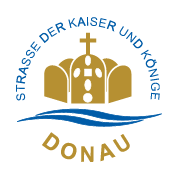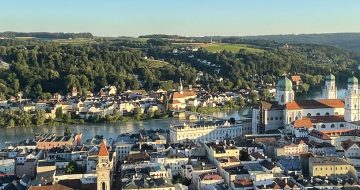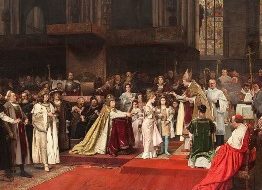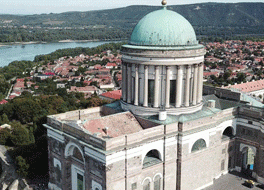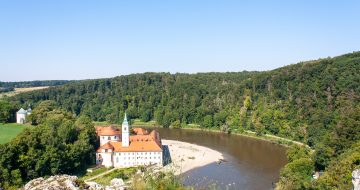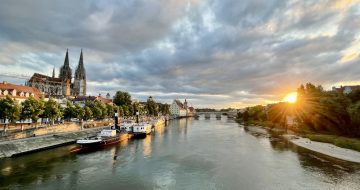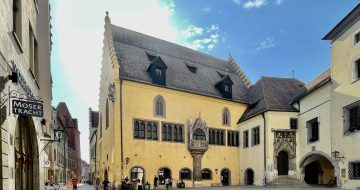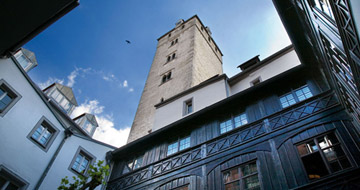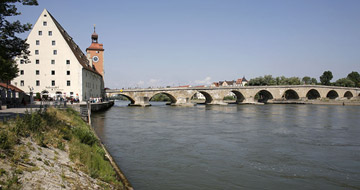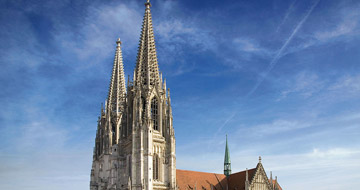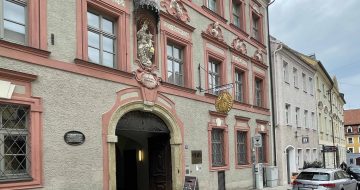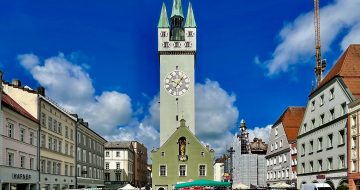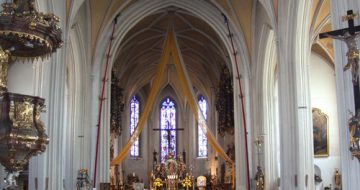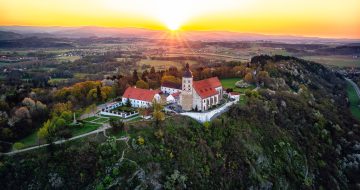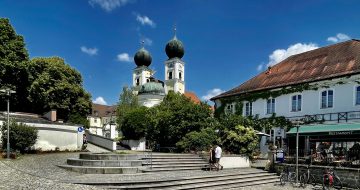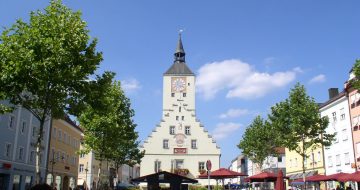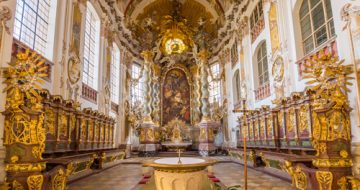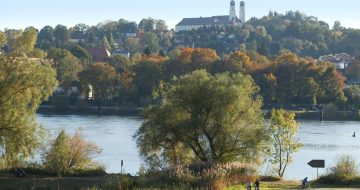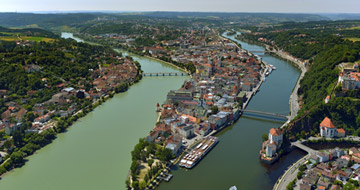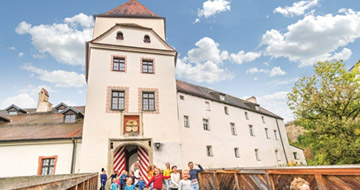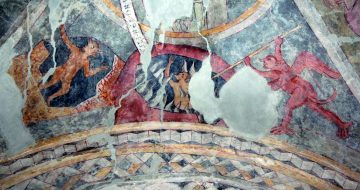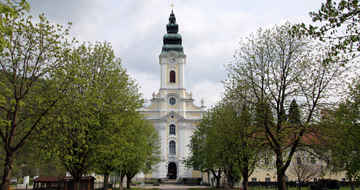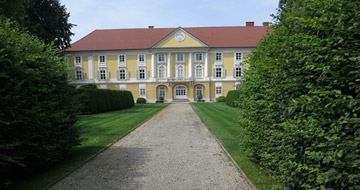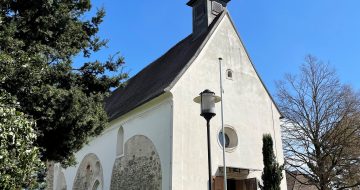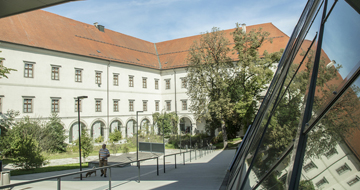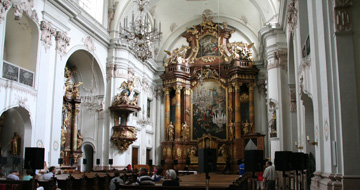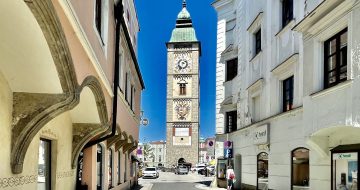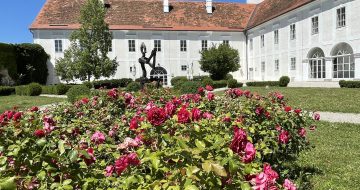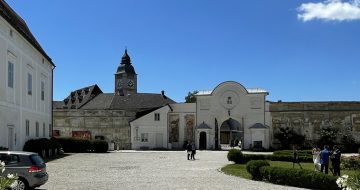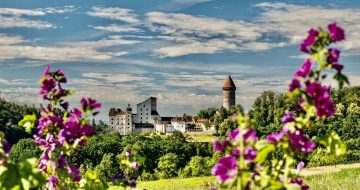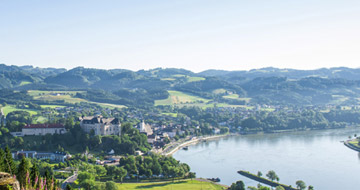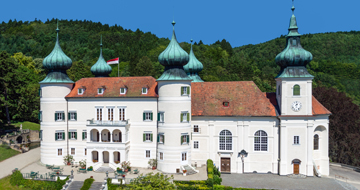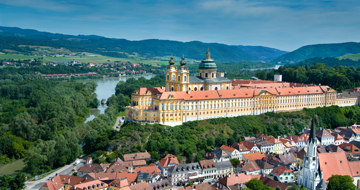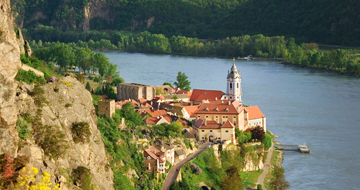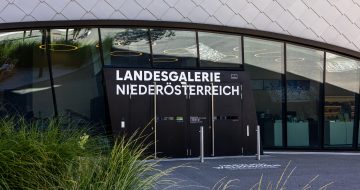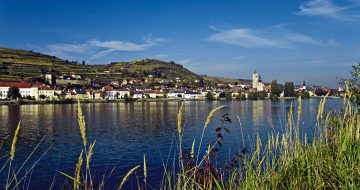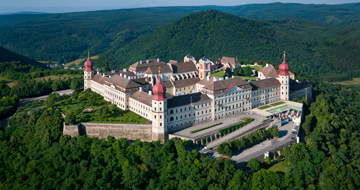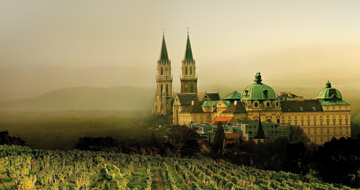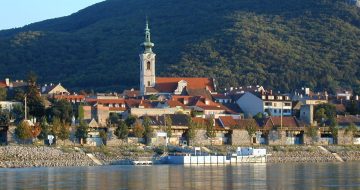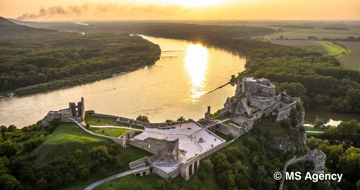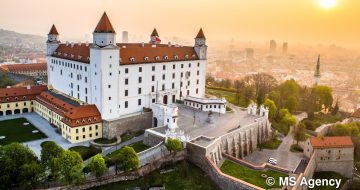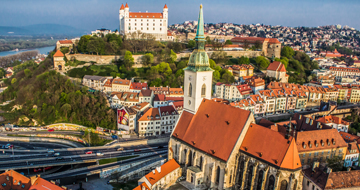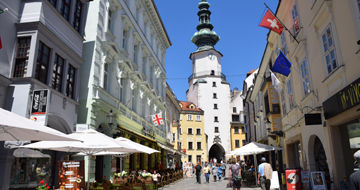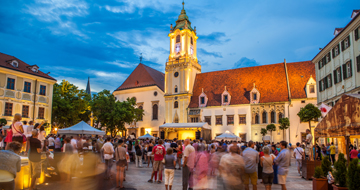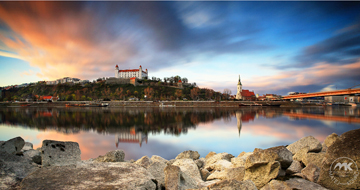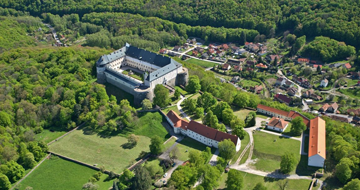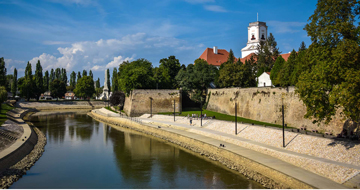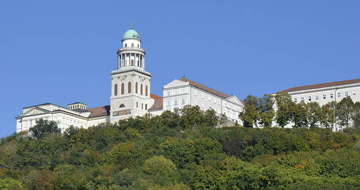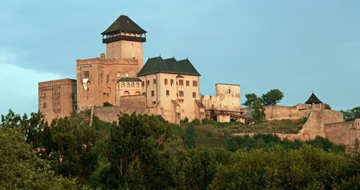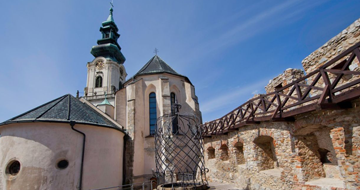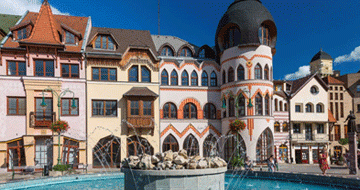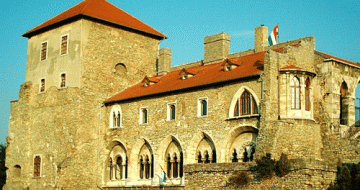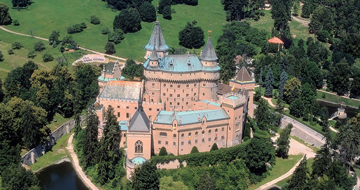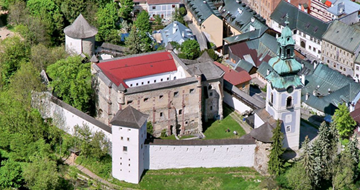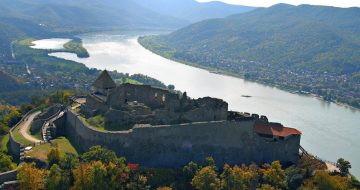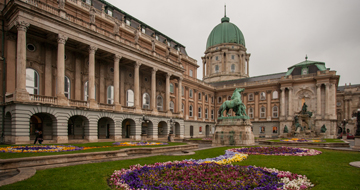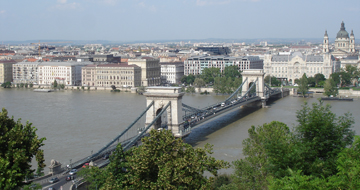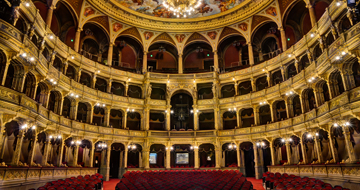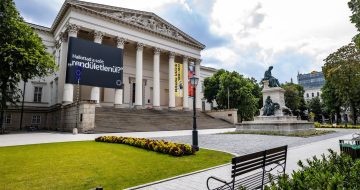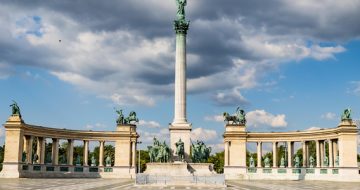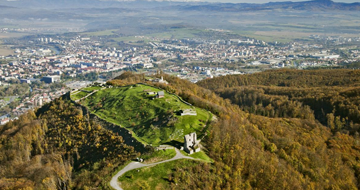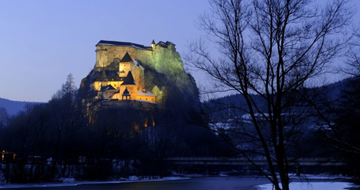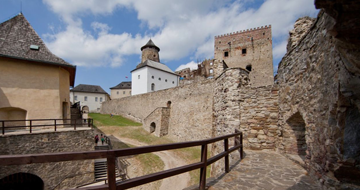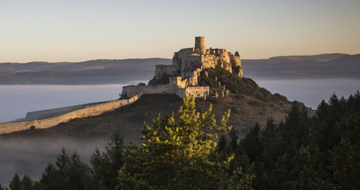Middle Ages
The Early Middle Ages
Christianity spread early along the Danube. Saint Florian is the first Danube saint. Because he, the Roman civil servant, refused to sacrifice in front of the emperor Diocletian's image, on May 4, 304, with a millstone around his neck, he was thrown into the Enns near Lorch, which drove him with a strong current towards the Danube. There, where according to legend his body landed, the foundation stone of the canonical monastery of Saint Florian was later laid. Thus, despite the political turmoil, a lively early Christian culture developed in the Danubian provinces.
The decline of Roman power in the Danubian provinces was not a sudden event, but rather a long, crisis-ridden development process that lasted for decades. The administrative framework crumbled. Not only the warlike events, but also economic decline and population decrease were responsible for it. The highly developed ancient infrastructure, roads, bridges aqueducts and Danube ports fell into disrepair. The Romans were no longer able to counter the final advance of the Germanic tribes across the Danube at the end of the 5th century. However, since the later inhabitants, the Germanic Bajuvars, still encountered Romansh-speaking people ("Walchen") in the 6th century, we may assume the survival of Roman and Christian culture.
The exodus of Roman soldiers and officials was by no means followed by the entire provincial population. The end of Roman military and civil power is not synonymous with the end of Roman culture. And the Germanic tribes that had settled on Roman territory had long since ceased to be pagan barbarians. Their empire-building continued the Roman tradition. It seems to have become customary for the leading clans of the immigrating peoples in particular to set up their residences and seats of power within old Roman walls. We can observe such new life sprouting from the ruins in many places along the Danube, in Regensburg, Passau and Budapest.
In the course of the reorganization of the ecclesiastical system, numerous monasteries were founded under the Bavarian dukes as centers of state expansion, Niederalteich, Metten, Niedernburg in Passau and Sankt Florian before the mouth of the Enns.
Charlemagne is the next outstanding emperor figure that we encounter on the Danube after the Roman era. With him, a new chapter in our European history begins. In the year 800, he had himself crowned emperor in Rome and thus claimed the universal rule of his Roman predecessors. Charles and his son Pippin used the Danube as a military route during their military and missionary campaigns. Imperial stays in Regensburg and Lorch are historically attested. The Carolingian Empire extended deep into Pannonia, today's Hungary. Charlemagne's successors preferred Regensburg as a royal city. The following dukes from the Saxon, Frankish, Guelph and finally the Wittelsbach dynasty also took up residence here. Almost all emperors and kings stayed in the city for a long time and made decisions for the empire from here. The Emmeram monastery in Regensburg experienced a period of spiritual prosperity under the imperial bishop Wolfgang. In 975 he founded a singing school from which the "Regensburger Domspatzen" emerged. The possessions and rights of the Regensburg diocese extended far down the Danube. An important base was Pöchlarn, which remained Regensburg until 1803.
It is hard to believe that the Hungarians, so friendly today, are the descendants of those Magyars who, in the first half of the 10th century, ravaged all of Europe with their Hun-style war campaigns. They used the Danube as an incursion route for their cavalry raids. But then Emperor Otto I hit them so hard on the roof, or rather on the helmet, that they vowed to stay in Hungary and become Christian. Especially Passau excelled in the following eastern mission of the middle Danube region. Along the Danube, numerous Passau daughter churches were founded after 970. The most famous was to become Vienna in 1147. The Viennese "Steffel" still reminds of the St. Stephen's patrocinium of the Passau cathedral. From the 8th to the 11th century, the diocese of Passau grew not only into the largest diocese of the Danube region, but of the entire Roman-German Empire! Bishop Pilgrim of Passau had a spectacular success with the Hungarians. In 973 his missionaries baptized the young Grand Duke's son Vajk under the name of Passau's diocesan patron Stephan (Hungarian: István). The young ruler confirmed his conversion to Christianity when he married Gisela, the sister of Emperor Henry II the Saint, in 997. With her we meet the first outstanding female personality on the Danube, the first Christian queen of Hungary, Gisela. The bridal journey went down the Danube - from Regensburg to Esztergom. A year after the turn of the millennium, Stephen received the apostolic royal crown from the Pope and on Christmas Day of the same year 1001 he was anointed king in the castle church of Gran (Esztergom). The "Crown of Stephen" (Szentkorona, Holy Crown) sent from Rome at that time has lost none of its symbolic power of Hungary's independence to this day.
After the Hungarian mission, the settlement and colonization of Ostmark was again pushed forward from Bavaria. Ostmark (Marchia Orientalis), that was the Danube land east of the Enns, granted to the Babenbergs as a margraviate by Emperor Otto II in 976. In a deed of donation dated 996 it is called Ostarrichi (Austria) for the first time. The Austrian dukes built their residences on the Danube. From their first castle in Pöchlarn they moved to Melk in 984, then to Tulln around 1050 and to Klosterneuburg in 1106 and finally to Vienna in 1156.
The High Middle Ages
In the age of the Crusades, the Danube played a less than peaceful role as a military route. Masses of pilgrims with more or less pious intentions rolled along the river from the 11th to the 13th century to reach the "Holy Land" via the Balkans and Asia Minor. Regensburg served as a rallying point for the Crusaders. The "Stone Bridge", completed in 1146, enabled the rapid crossing of the river for the massive armies. In 1189, Emperor Frederick Barbarossa himself placed himself at the head of the Third Crusade. In Regensburg, he and his court boarded Danube ships, preceded by barges carrying provisions, tents and weapons. The land army marched on the right side of the river. From Vienna, then already the capital of the Babenberg dynasty, the Staufer emperor set off further east. The magnificent festivities on the Danube left a deep impression on contemporaries. Admittedly, only a few crusaders reached their destination in the Promised Land and even fewer returned home.
An episode of the Crusade period is also the spectacular capture of the English King Richard the Lionheart by the Austrian Margrave Leopold the Virtuous. Both were participants in the crusade, but got into irreconcilable personal quarrels. When King Richard wanted to return home unrecognized through Austria in 1192, he fell into the hands of his enemy, who had him imprisoned in Dürnstein Castle in the Wachau region and released only after a ransom payment of 23 tons of silver. Leopold used the money to expand the two Danube border towns of Enns in the west and Hainburg in the east. Vienna, capital of the Ostmark since 1156, almost experienced a second founding through extensive building activity.
The new trade route The Crusades did have one positive effect: international trade grew enormously. Oriental goods now found their way to the West. And the Danube served as a transport route. Thriving trading cities now lined the river: Regensburg, Passau, Linz, Krems and Vienna. The first stone bridge spanned the river in Regensburg, marveled at as the ninth wonder of the world! The waterway enabled the transport of large quantities of goods. The west-east direction of the Danube, unique in the European river system, offered it a monopoly position in long-distance traffic and transit of goods from west to east. Since the 12th century, a uniform, pulsating economic area developed from Regensburg along the Bavarian and Austrian Danube to Hungary.
Signs of high medieval chivalry are the castles, noble dwellings and fortifications, which - to show the "elevated" position of the owner - were symbolically enthroned on mountain heights. And of course, it was the rocky high banks of the Danube that exerted the greatest attraction on castle builders. Visible from afar as pillars of medieval rule, a stately number of castles still loom large today. Donaustauf behind Regensburg, Aggstein in the Wachau, the rock castle Devin in front of Pressburg and the Hungarian royal castle Visegrad in the Danube bend are mighty monuments of the European age of chivalry.
As if under a burning glass, the Crusades and the courtly era of knights and minstrels are condensed in the Song of the Nibelungs, the most important medieval heroic epic. The first part of the song - the Siegfried saga - has the Rheingau as its setting. However, the second part - the Nibelungen's march - takes place on the shores of the Danube. The epic is dated to the period from 1190 to 1204, and the author's name has not been handed down to us. However, there are many indications that he came from the Bavarian/Austrian Danube region. It is remarkable that he describes many Danube cities, which he obviously knew by sight: Plattling, Passau, Eferding, Pöchlarn, Melk, Traismauer, Tulln, Vienna and Hainburg. The Nibelungs passed through all these places on their fateful way to the east. The scene of the end of the drama is clearly traced to the Hungarian royal residence of Esztergom. The legendary "Nibelungen Road" is thus largely identical with the "Road of Emperors and Kings".
Anno 1180 Emperor Barbarossa gave the Duchy of Bavaria to the Wittelsbachers. For more than 700 years, until 1918, this noble family will rule over Bavaria and thus over the Bavarian Danube as dukes, electors and finally as kings. The Wittelsbach grants of city rights to Straubing (1218) and Deggendorf (1250) show the importance with which the dukes treated the waterway. When they won the large Danube county of Bogen through clever marriage policy in 1242, the Wittelsbachs crossed the Danube and reached the Bavarian Forest. By the way, they took over the white-blue lozenges from the Counts of Bogen into the Bavarian coat of arms. At the end of the 13th century, the Danube flowed through Wittelsbach territory on both sides from the Altmühl to Engelhartszell. The bishopric of Passau had risen to the status of a prince-bishopric by imperial privilege in 1220, thus unifying spiritual and secular power "under the crook". An outstanding personality was Wolfger von Erla, who sat on the bishop's chair from 1194 to 1204. In his entourage, the minnesinger Walther von der Vogelweide appears for the only time in an official document in 1203: Wolfger pays "the singer Walther von der Vogelweide six solidi to a pelt". Until secularization in 1803, the Passau prince-bishops ruled independently of Bavaria and Austria. The Bavarian dukes had to withdraw from Regensburg after the city had been privileged with liberties in the 13th century, which made it subject to the emperor alone as a Free State of the Empire. Regensburg became the proverbial "lost capital of Bavaria". Until the end of the Middle Ages, the city represented the largest and politically as well as economically and culturally most important community in the entire southern German region. The Regensburgers presided over the Fondacco dei Tedeschi in Venice, the central storehouse of the German merchants who traded with the Orient. The minnesinger Wolfram von Eschenbach admired Regensburg's zindal fabrics (silks) in his epic Parsifal. In the middle of the 13th century, construction began on the Cathedral of Saint Peter. Bishops, citizens, monasteries and also the duke participated in building a magnificent Gothic cathedral in the French style. Nobody expected that the construction would last until 1869.
Linz was long dependent on the bishops of Passau. However, this changed when the city was purchased by the Austrian dukes in 1210. For them, Linz, situated on the border with Bavaria and in the middle of the Passau Danube estates, was of high strategic importance. This may explain the rapid privileging and expansion under the Habsburgs. At the castle, impressively situated above the Danube, resided the captains of the "Land ob der Enns" appointed by the Austrian dukes, from which the province of Upper Austria would gradually emerge. Since the 13th century, the Enns River has separated two administrative districts of the Ostmark, or the Duchy of Austria, namely the "Land unter der Enns" (Lower Austria) from the "Land ob der Enns" (Upper Austria).
Leopold III, called the Saint, moved into his residence in Klosterneuburg in 1106, at the mountain-framed gateway to the Vienna Basin. His successor Henry II Jasomirgott then settled down the Danube in Vienna in 1156. This up-and-coming settlement in the climatically favorable Vienna Basin offered rich opportunities for development. Along the axis Kohlmarkt-Graben-Unter den Tuchlauben lived the merchants, whose range of goods had expanded considerably as a result of the crusades and pilgrimages. Soon the new quarter around the new St. Stephen's Church was included. The Babenberg court in Vienna was frequented by minnesingers such as Reinmar von Hagenau, Neithart von Reuenthal and the Nibelung poet, whose name we do not know. Walther von der Vogelweide exclaimed: "Daz ist der wünnecliche (wonnereiche) hof ze Wiene". Ulrich von Lichtenstein rode into the city in the merry month of May 1227 dressed as Frau Venus and was duly celebrated by the Viennese court ladies. In the 14th century, Vienna was considered "the largest city in the empire after Cologne". We estimate its population at that time at 20,000 inhabitants. The Hungarian Stephen's Empire was one of the richest and most powerful states in medieval Europe because of its gold deposits. Its kings resided in Bratislava (which belonged to Hungary until 1918), in Győr (German: Raab), in Esztergom and Visegrad. Since the 14th century, Buda crystallized as the capital, still separate from Pest, the commercial city located across the Danube.
The late Middle Ages
With the accession of Rudolf I to the throne in 1273 began the series of Roman-German kings and emperors from the family that determined the destiny of the Danube region until 1918: The Habsburgs. Since the accession of Frederick III (1440), the House of Habsburg was regularly entrusted with the imperial dignity of the Holy Roman Empire of the German Nation until 1806. And under Emperor Frederick III, the contours of a Habsburg Danube monarchy emerged for the first time. Frederick's proverbial phlegm - he was regarded as "the empire's arch-sleeping cap" - in fact resulted in an exceptionally long life (1415-1493), which enabled him to simply outlast fellow rivals and opponents. He was able to hand over to his successors the Habsburg domains, which had been torn apart and endangered at the beginning of his reign, undivided and well ordered.
Above the Frederick portal of Linz Castle we read the monogram A.E.I.O.U. The enigmatic letters seem to refer to Frederick III and we also find them in other places, for example in the Rupprechtskirche in Vienna. To this day, people speculate about what it could mean: perhaps "Austria Erit In Orbe Ultima" (Austria will be supreme on the face of the earth) or "Austriae Est Imperare Omne Universum" (It falls to Austria to rule the whole world)? "Alles Erdreich ist Österreich untertan" seems to be a later German explanation.
And as if that were not enough, the marriage policy initiated by Emperor Frederick III really made the House of Habsburg a world power. This is what the two-liner refers to: "Bella gerant Alii, Tu felix Austria nube / nam quae Mars Aliis, dat tibi regna Venus" (Wars may be waged by others, you, happy Austria marry / for the empires that Mars gives to others are granted to you by Venus). There were four cleverly and farsightedly planned dynastic marriages that led to this: namely the marriage of the heir to the throne Maximilian I to Mary of Burgundy, the Spanish marriage of Maximilian's son Philip the Handsome to Joan the Melancholy, and the two marriages to the Polish ruling dynasty that would eventually bring the Habsburgs the Bohemian crown of Wenceslas and the Hungarian crown of St. Stephen. By 1500, the Danube and Alpine regions were essentially united under the Habsburgs. The dynasty name Habsburg and the country name Austria, Austria, merged into one synonymous term.
Hungary still experienced a golden end of the Middle Ages. Under King Matthias Corvinus and his beautiful wife Beatrix of Naples, the Italian Renaissance arrived in the Hungarian royal cities. In Visegrad above the Danube rose the first Renaissance palace outside Italy. Artists and scholars admired the royal couple's precious collection of books, the highly famous Bibliotheca Corvina in Buda. The Matthias Church in Budapest is still a reminder of the "good king" revered by the people. But after the death of the ruler in 1490, a new power approached from the southeast: the Turks under their powerful Ottoman sultans. Hungary turned into a battlefield between the Habsburgs and the Ottomans for 200 years.
